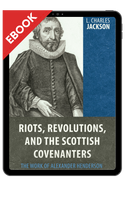
Jackson, L. Charles
Coauthor of the famous Scottish National Covenant, moderator of the Glasgow General Assembly that defied King Charles I, and member of the Westminster Assembly, Alexander Henderson (1583–1646) led Scotland during the tumultuous period of the British Revolutions. He influenced Scotland as a Covenanter, preacher, presbyterian, and pamphleteer and earned an important place in the nation’s history. Despite his numerous accomplishments, no modern biography of Henderson exists. In Riots, Revolutions, and the Scottish Covenanters, L. Charles Jackson corrects this omission. He avoids the extremes of casting Henderson as a forerunner to liberty or as a theological tyrant and instead places his actions in their historical setting, presenting this important leader as he saw himself: primarily a minister of the gospel who was struggling to live faithfully as he understood it. Using neglected and, in some cases, new sources, Jackson reassesses the role of religion in early modern Scotland as reflected in the life of Alexander Henderson.
Table of Contents:
Introduction
Author
L. Charles Jackson (PhD, University of Leicester) is the senior minister at Covenant Presbyterian Church (OPC) in Vandalia, Ohio. His other books include Faith of Our Fathers: A Study of the Nicene Creed and Bible Studies on Ruth. He and his wife, Connie, have six children.
Endorsements
“There has long been a need for a modern, scholarly study of Alexander Henderson, the most important clerical leader of the Scottish Covenanters. Charles Jackson’s carefully researched work helps us to understand why Henderson was so effective and why his death in 1646 was such a loss to the Covenanter movement. The book engages with a number of debates among historians and highlights the importance of religion in Covenanter ideology. It will be of particular interest to students of the British Civil Wars, presbyterianism, and the Reformed tradition.” — John Coffey, professor of early modern history, University of Leicester
“At last, a scholarly biography of Alexander Henderson, perhaps the greatest of the architects of post-Reformation presbyterianism. Henderson was one of the key Scottish commissioners at the Westminster Assembly and helped significantly to mold the Assembly’s documents into the timeless theological legacy that has been bequeathed to the Reformed church in particular, and the wider Christian church in general. Charles Jackson has written an engaging, insightful, and stirring biography of one of Scotland’s greatest pastor-theologians. This is a book not just for history buffs but for anyone interested in understanding the thinking and actions that gave birth to a church polity and mindset that impacted the world, not least of all the United States.” — Ian Hamilton, minister of Cambridge Presbyterian Church, Cambridge, England, and author of The Erosion of Calvinist Orthodoxy
“Serious students of early modern Scottish history now have a balanced interpretation of one of Scotland’s most important, but long-neglected church leaders. This well-researched and carefully documented examination of Alexander Henderson and seventeenth-century history affirms a convincing thesis about the great significance of ecclesiology in the formative years of presbyterian development. Its analysis of the Westminster Assembly is especially informative.” — James E. McGoldrick, professor of church history at Greenville Presbyterian Theological Seminary
“Alexander Henderson’s life-sized likeness is displayed in the National Gallery of Scotland. Anthony van Dyck captures a man, Bible in hand, who is serious but not stern, handsome without a hint of arrogance. The painting is a symbol of a colorful and complex life. Henderson spent his best years of his life fighting popery, episcopacy, and abuses of the royal prerogative. But van Dyck was the (Roman Catholic) court painter of England and the man responsible for the celebrated likenesses of Henderson’s two greatest opponents: Archbishop William Laud and King Charles I. Perhaps more than any other Scottish churchman in the seventeenth century, Henderson expertly navigated relationships with people who were supposed to be his enemies and commanded respect outside the large circle of his loyal supporters. People were willing to pause and consider what he had to say: in his own Scottish kirk, at the Westminster Assembly, in the rebel parliament, and in the royal court. Dr. Charles Jackson’s new book, years in the making, captures the landscape of Henderson’s life and offers a thoughtful sketch of the man himself. I share his hope that this study will help us to pause and consider what Henderson may have to say to our own generation.” — Chad Van Dixhoorn, associate professor of church history, Reformed Theological Seminary